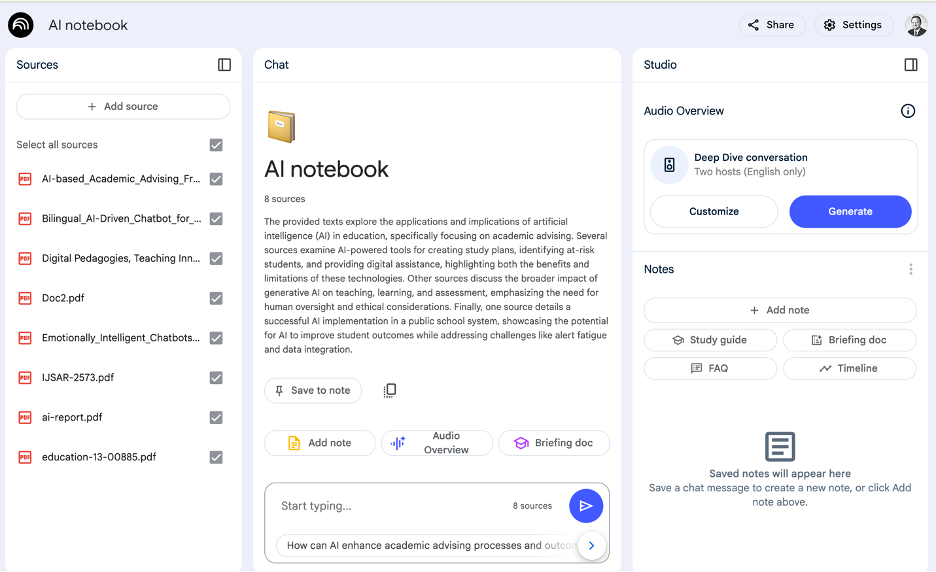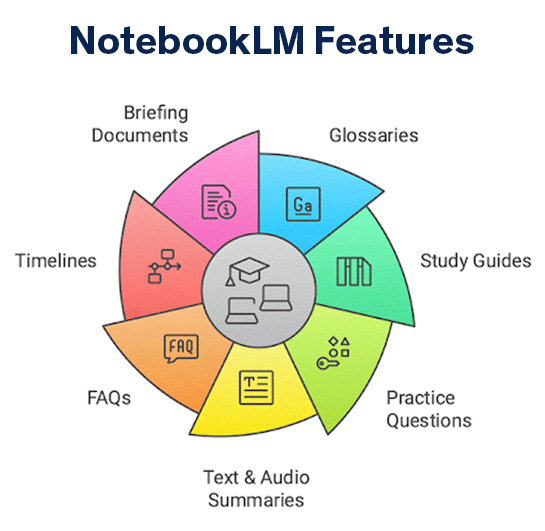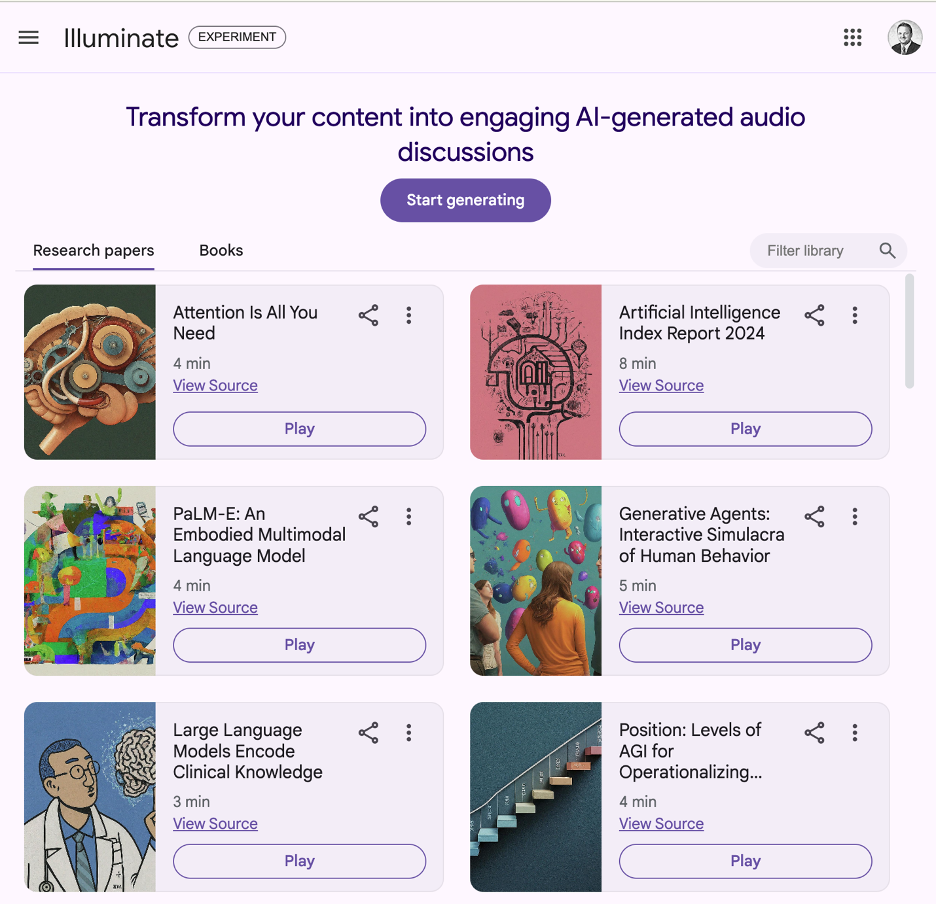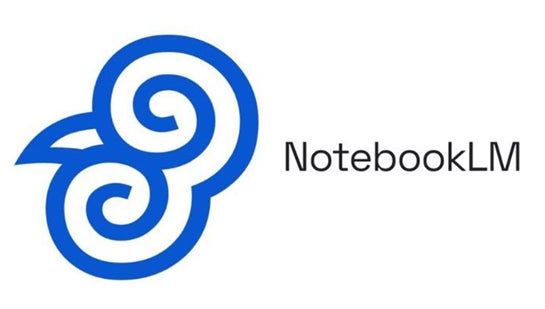AI in the Classroom: From Complex Texts to Engaging Learning Experiences
quote
By uploading course materials, textbook chapters, and research papers, faculty can leverage the AI to generate comprehensive study guides, concise summaries, key topic outlines, practice questions, document timelines, and briefing documents.
text 1

University students today face an increasing challenge: making sense of sophisticated academic content. As course materials become more diverse and technical, many students struggle to effectively comprehend and retain information from complex texts. NotebookLM, developed by Google and led by renowned author Steven Johnson, offers an innovative AI-powered solution to assist in reading comprehension. This tool changes how readers and researchers work with their source materials, providing a range of features designed to enhance the learning experience.
What is NotebookLM?
NotebookLM is an AI-powered platform developed by Google. The platform offers a suite of features designed to improve how students and researchers interact with academic content. One of its most exciting capabilities is the generation of audio overviews and podcast-style summaries of complex texts. This audio-first approach can benefit students with reading difficulties, including dyslexia. By offering pre-reading audio summaries, NotebookLM prepares students for deeper engagement with the material, setting the stage for more meaningful classroom discussions and written assignments.
For example, you can enjoy a 12-minute audio summary of this article, which not only condenses the main ideas but also provides detailed background information for greater context. The virtual podcast hosts received custom instructions to effectively engage instructors and staff from the University of Illinois Chicago during their presentation. NotebookLM generates this summary to surface the key points and enrich your understanding of the subject matter.
The platform also serves as an intelligent study companion during the active reading process. Students can engage in real-time Q&A sessions with their source material, receiving clarifications on complex terms and concepts. This interactive feature encourages active engagement with the text, potentially promoting deeper understanding. NotebookLM grounds its responses in the uploaded materials, ensuring students work with accurate information directly related to their course content. Additionally, the platform can generate glossaries, study guides, practice questions, one-click text summaries, FAQs, timelines, and briefing documents, providing valuable scaffolding to help students better understand and retain complex information (Figure 1).
text 1

Benefits of NotebookLM for Academic Reading and Writing
NotebookLM enhances academic reading by optimizing both lateral and vertical reading processes. Lateral reading, which involves examining multiple sources to verify claims and build context, becomes more effective through the platform’s intelligent source management and connection features. The system helps students efficiently review and compare multiple sources, establishing relationships between texts and identifying key themes before studying any single source in depth.
Once lateral reading establishes the broader context, NotebookLM supports vertical reading — the detailed examination of individual sources through interactive conversations and audio summaries focused on specific sources or questions. This dual approach ensures thorough understanding: first grasping the broader field through lateral reading, then exploring deeply through vertical reading with AI-assisted comprehension tools.
NotebookLM (Figure 2) excels as a powerful focus tool for writers and researchers, improving how they document and develop their projects. The platform creates an organized system for the writing process through three key components:
- Source Collection: Methodical gathering and organization of reference materials
- Source Connection: Intelligent linking of related concepts and themes across documents
- Topic Architecture: Maintaining clear structural placeholders that grow with the project
text 1

How UIC Instructors Can Use NotebookLM
For instructors at the University of Illinois Chicago (UIC), NotebookLM serves as a powerful tool for course preparation and content delivery across various disciplines. By uploading course materials, textbook chapters, and research papers, faculty can leverage the AI to generate comprehensive study guides, concise summaries, key topic outlines, practice questions, document timelines, and briefing documents. For example, history or literature instructors can create chronological timelines of events or ideas, while science and engineering faculty can summarize key concepts and recent advancements. These AI-generated resources can be exported and uploaded directly to the Blackboard LMS course, providing students with valuable study aids and a clear, concise overview of the course material.
How UIC Students Can Use NotebookLM
UIC students can use NotebookLM to enhance their learning and research processes in numerous ways. They can upload lecture notes, assigned readings, and additional resources to create personalized study guides. NotebookLM’s ability to synthesize information from multiple sources is particularly useful for research projects or when preparing for comprehensive exams. Students can also use the platform to generate FAQs about complex topics in their courses. By uploading relevant materials and asking the AI to create frequently asked questions with answers, they can reinforce their understanding and identify areas that need further study. These self-generated FAQs can be shared with classmates through Blackboard’s discussion forums, fostering collaborative learning.
Curated Journal Articles With Optimized Audio Overviews
Google Illuminate is an innovative experimental project that builds upon the success of Google NotebookLM. This article gallery aims to curate a collection of high-quality articles, complete with pre-generated audio overviews, to enhance the learning experience and showcase optimized audio content (Figure 3). The project represents an exciting step forward in the use of AI for educational purposes and content accessibility.
text 1
Accessing and Getting Started with NotebookLM
To access NotebookLM, users should navigate to notebooklm.google. UIC students and faculty may need to log out of their UIC Google accounts and sign in with a personal Google account to access the service. Google Illuminate, an innovative experimental project that builds upon NotebookLM, can be accessed at illuminate.google.com and is compatible with both personal and UIC Google accounts. The main features of NotebookLM are free, with a premium service available for group content collaboration.
Potential Limitations and Ethical Considerations
While NotebookLM offers significant benefits, it’s important to recognize its limitations to ensure responsible and effective use. One concern is the potential impact on students’ agency over their learning process. It’s essential that students, particularly in upper-level courses and graduate programs, are encouraged to engage deeply with primary sources and develop independent analytical skills. Faculty should emphasize the importance of critical analysis beyond AI-generated content. Promoting reflective learning is crucial. UIC instructors can design assignments that require students to critically evaluate NotebookLM’s outputs, fostering a deeper understanding of both the subject matter and the capabilities and limitations of AI in academic contexts.
The simplification of complex topics can be in some situations a drawback. While NotebookLM’s audio summaries and simplified explanations make content more accessible, they can “flatten” nuanced academic discussions, which may not be suitable for advanced coursework in disciplines like law, biochemistry, or theoretical physics. Faculty should ensure that students understand these summaries are starting points rather than comprehensive analyses.
Ethical concerns also arise regarding data privacy and security. Although NotebookLM does not use uploaded data to train its models, UIC faculty and students must exercise caution when uploading sensitive information. For example, patient data in medical or nursing courses must comply with HIPAA regulations, while student records must adhere to FERPA guidelines. Using anonymized or synthetic data is strongly recommended when working with case studies or clinical information.
text 1

NotebookLM also faces challenges related to algorithmic bias and misinformation. Like other generative AI tools, it relies on its training data, which may perpetuate biases or inaccuracies present in those sources. For example, minority perspectives might be underrepresented in generated content, potentially skewing research or learning outcomes. Faculty should encourage students to cross-check AI outputs against reliable sources and remain critical of potential biases.
Finally, there is a risk of academic misconduct if students misuse NotebookLM to complete assignments without proper attribution or understanding. This could undermine intellectual growth and academic integrity. UIC instructors should establish clear guidelines on appropriate use of the tool and educate students on ethical practices when integrating AI into their work.
Final Thoughts
NotebookLM represents a significant advancement in educational technology, offering powerful tools to enhance reading comprehension, research skills, and academic writing. For UIC faculty and students, it presents an opportunity to transform complex academic content into engaging learning experiences. While the platform offers exciting possibilities, it’s crucial to use it responsibly and in conjunction with traditional learning methods. UIC faculty are encouraged to explore NotebookLM’s potential in course design, creating dynamic study materials and fostering interactive learning environments. Students should leverage the tool to deepen their understanding of course content, improve their research processes, and develop critical thinking skills.